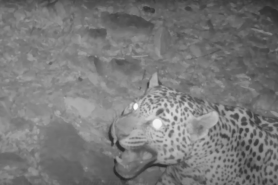

This weekend, a pair of shepherds was moving their flock through Northern India when lightning struck a nearby tree. When the flash of light faded, the two men looked around, stunned: Hundreds of their goats lay dead on the ground, apparently electrocuted.
Videos by Outdoors with Bear Grylls
The total death toll amounted to about 350 animals, reported India Today. The event is currently under investigation, though no one doubts that it was the lightning that did in the herd. But how could this have happened?
The grisly truth is that mass-casualty events like this are fairly common. In 2016, a similar massacre occurred in Norway, leaving about 320 reindeer dead in a single meadow. No one was there to see it happen, but scientists theorized that it was caused by a bolt of lighting, which sent a strong electrical current through the ground. Since animals’ bodies conduct electricity, the grounded lightning was attracted to the caribou and moved through them as it spread out through the earth.
“The electricity would go up one leg of [each caribou’s] body and stop the heart and go down and out another leg,” lightning specialist John Jensenius told The New York Times then. He added that this can happen to people, but it’s less common. That’s because bipedal humans only have two points of contact with the ground, and electricity doesn’t have to pass through the heart to go up one leg and down the other.
In the case of the goat herd, the same thing likely happened: the tree attracted lightning, pulling it into the ground where it spread out and then shot up hundreds of goat legs. The result was a mass electrocution.
Though it’s not unheard of to have lighting strikes take out whole herds of livestock, the recent event in India is the most destructive single strike we can find a record of in the past several decades. In 2012, more than 100 goats were killed by a lightning bolt in China, and in 1918, about 650 sheep were killed in Utah by a pair of adjacent strikes.









